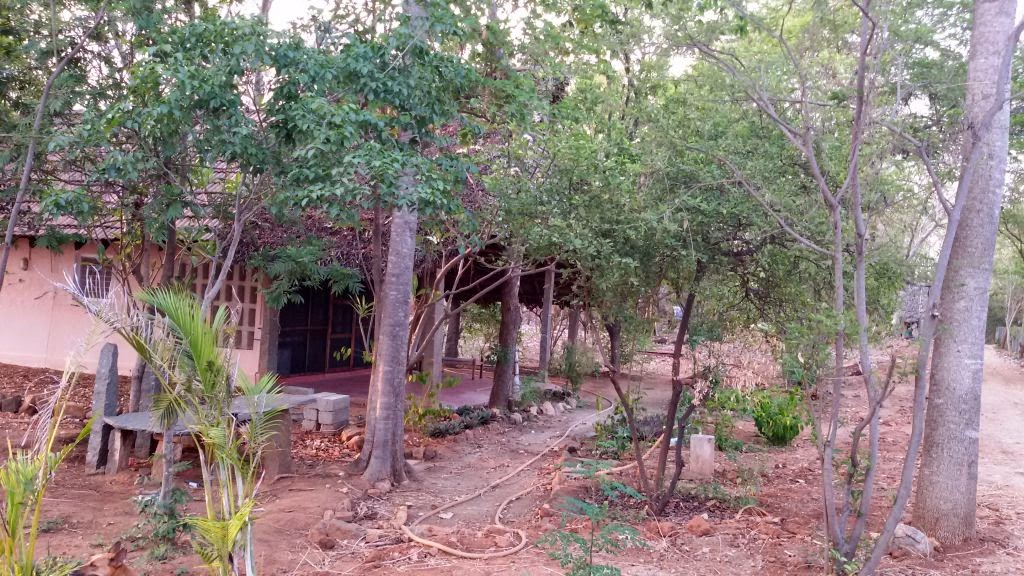Bombax Malabarica or Silk Cotton Tree (Ilavam, Pulai) is a genus of tropical trees of the Mallow family. It is a reddish, silky tree which belongs to the family of Malvaceae. The genus is best known for the species B. Ceiba which is widely cultivated throughout South Asia. As the tree does not fare well in arid climates, to grow in this area it needs careful attention. It can be seen at several areas at Tiruvannamalai.
The Silk Cotton is a tall handsome tree which can grow up to a 100 feet in height. The tree forms a straight bole with horizontal or upward branches that grow in regular whorls, tier above tier, like a gigantic upside down candelabrum. The trunk and branches are usually covered with conical thorns especially when young. Thorns on older trees are often absent.
The leaves of this tree fall off just before it flowers. The flowers are 6 to 7 inches long and are up to 7 inches wide. They are borne solitary or in clusters at or near the ends of the branches. The flower consist of five satiny, red, scarlet, or sometimes white petals. Intense blooming of this tree lasts around 29 days. The fruit contains small brown black seeds embedded in white cottonwool; when the trees’ pods burst open, the cotton is carried in the air and the seeds fall and propagate both by air layering and also by bird dispersal.
This tree is immensely popular with many species of birds such as: Bulbuls, Mynahs, Sunbirds, Flower-peckers and Crows who are all attracted to the nectar of this trees’ flowers.
 |
| Flowers in full bloom |
The Red Silk Cotton has many valuable ethno medicinal and ayurvedic uses.
Some of which include:
Root: Diarrhoea, dysentery, diabetes, scorpion sting and snakebite, brain tonic
Stem and Bark: Bacterial, viral, heart tonic, kidney stone, easy delivery
Gum: Asthma, dental caries, scabies, dysentery
Leaves: Glandular swellings, rheumatism
Flower: Anemia, Colitis, internal bleeding
Fruit: Anti-fertility agent
Fruit and Heartwood: Anti-diabetic, snakebite
Seed: Chicken pox and small pox
Spines: Skin troubles, headaches
This tree is also widely used commercially for timber, packing boxes, floating logs for fishermen and gum utilised in both the cosmetic and food industry.
 |
| Photograph showing branch arrangement |
There are many myths, legends and traditions associated with this large deciduous tree. In one such myth, the tree is said to be the tree of infernal region and the thorny appearance has led it to be called as Yamadruma, the tree of Yama (the Lord of Hell). Its cuplike flowers are considered sacred to Shiva. When the tree is in full bloom it is compared to Lakshmi, the goddess of good fortune, standing with her arms outstretched and a lit oil lamp on each palm.
One myth of this tree can be found in the Mahabharata and goes like this:
Tale of the Tree
During their exile in the forest the Pandava brothers worked in the forest, hunting, clearing and gathering fuel.
At night the wife of the Pandava brothers would massage one of her husbands after their heavy workday. One evening Bhima deciding to trick Draupadi, brought in a log of Semal (tree name in Hindi) wood to his room, put it in his bed and covered it. Bhima hid outside to watch the fun while someone called Draupadi to the room.

Draupadi began massaging Bhima, remarking how tired he must be as his body and knotted muscles felt very hard. Continuing to massage her husband, Draupadi asked several times whether he was satisfied with her work. Receiving no answer and loosing patience, she finally snatched away the sheet off the form in the bed, and found that it had been covering not her husband Bhima, but a log of wood. She cursed the wood from that day onward that the wood would grow thorns always.
After Draupadi left the room, her husband climbed back, picked up the log of wood and took it outside to open land and planted it. Whereupon it grew into a tall tree with thorns on its trunk.
















































_flowers_at_Hodal_W_IMG_1163.jpg)



